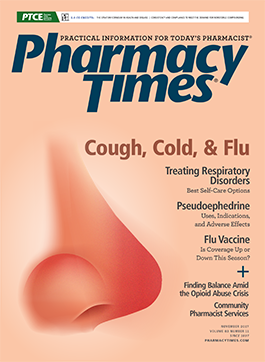Publication
Article
Pharmacy Times
Pseudoephedrine: Uses, Indications, and Adverse Effects
Author(s):
Pseudoephedrine has been around since the 1920s.
Pseudoephedrine has been around since the 1920s. Although the drug occurs naturally in certain plants (eg, ma huang), the majority that is produced derives from yeast fermentation of dextrose in the presence of benzaldehyde. Pharmaceutical manufacturers in China and India produce the bulk of commercially available pseudoephedrine.
MECHANISM OF ACTION
Pseudoephedrine is a sympathomimetic drug belonging to the phenethylamine and amphetamine chemical classes. Its principal mechanism of action depends on its effects on the adrenergic receptor system, causing vasoconstriction. Pseudoephedrine hydrochloride and its sulfate salts are found in an abundance of over-the-counter medications, either as a single ingredient or in combination with other ingredients, such as anti- histamines, acetaminophen, guaifenesin, nonsteroidal anti-inflammatory drugs, and dextromethorphan.1
INDICATIONS
The most common indication for pseudoephedrine is as a decongestant, for conditions including nasal congestion, sinus congestion, and eustachian tube congestion, as it shrinks swollen nasal mucous membranes and reduces tissue hyperemia and edema.2 Other uses include vasomotor rhinitis, first-line treatment for priapism, and off-label use for hyperprolactinemia, while veterinarians often use pseudoephedrine off-label to treat incontinence in dogs and cats.2 In conjunction with other medications, pseudoephedrine is often used to treat allergic rhinitis, croup, sinusitis, otitis media, and tracheobronchitis.1
ADVERSE EFFECTS
Some adverse effects of pseudoephedrine that typically do not need medical attention and that may subside during use include nervousness, restlessness, and trouble sleeping. Less common are dysuria, syncope, tachycardia, palpitations, headache, nausea and vomiting, trembling, and weakness.3
DISEASE INTERACTIONS
Pseudoephedrine is contraindicated in patients with type 2 diabetes, as it may increase glucose levels.4 Patients with glaucoma or a predisposition for glaucoma should not use pseudoephedrine because of its vasoconstrictive qualities.4 The same is true for prostatic hypertrophy4. Pseudoephedrine may worsen the following conditions: cardiovascular disease, severe or uncontrolled hypertension, severe coronary artery disease, ischemic heart disease, and hyperthyroidism.4
DRUG INTERACTIONS
Some products may interact with pseudoephedrine, including terbutaline and stimulants, such as caffeine, dextroamphetamine, and herbal products including ephedra and ma huang.5 Taking tricyclic antidepres- sants or monoamine oxidase inhibitors (MAOIs) with pseudoephedrine may cause a potentially fatal drug interaction called hypertensive crisis.5 Some MAOIs should be discontinued for 2 weeks prior to pseudoephedrine treatment.5 Finally, pseudoephedrine may reduce the effectiveness of certain antihypertensives, including beta-blockers and calcium channel blockers.5
PREGNANCY/BREAST-FEEDING
Pseudoephedrine has a pregnancy category of B.6 Some research has shown a possible link to birth defects when pseudoephedrine is taken within the first trimester of pregnancy.7 Although it is not known whether pseudoephedrine crosses the placenta, some think that its vasoconstrictive property of reducing blood flow to the uterus may be responsible for the defects when the drug is taken in the first trimester.
Pseudoephedrine is excreted in breast milk in small amounts. Fully breast-fed infants whose mothers took a full 60-mg dose of pseudoephedrine would receive between 2.2% and 6.7% of the maternal weight-adjusted dose.8 In 1 study, mothers reported irritability and/or agitation in about 20% of infants who were breast-fed after the mother ingested pseudoephedrine. The most significant adverse reaction to taking pseudoephedrine while breast-feeding is a decrease in milk production. A single dose of pseudoephedrine can significantly reduce milk production, and continued use could upset lactation,9 hence its off-label use for hyperprolactinemia.
PHARMACOKINETICS
Oral forms of pseudoephedrine are readily absorbed from the gastrointestinal tract and excreted principally unchanged in the urine. A small amount is metabolized in the liver and also excreted in the urine. The half-life of pseudoephedrine is between 5 and 8 hours, though the more acidic the urine, the lower the half-life.10
REGULATION
Pseudoephedrine can be illegally used to manufacture methamphetamine, which has become a national epidemic. The Combat Methamphetamine Epidemic Act of 2005 was incorporated into the Patriot Act on March 9, 2006, by President George W. Bush. This law bans over-the-counter sales of medications containing pseudoephedrine, so these products must be sold from locked cabinets or behind the pharmacy counter.11
The law also limits the amount of pseudoephedrine that a person can purchase daily (3.6 g) and monthly (9 g).12 Patients purchasing must present valid photo identification. Sellers are typically required to keep the name of the product, quantity sold, name and address of purchaser, the date and time of the sale, and the purchaser’s signature for a minimum of 2 years after the sale.12 Some states require that the seller be a pharmacist or a pharmacy technician. Check with your state board for clarification.12
Since the implementation of the Combat Methamphetamine Epidemic Act, it has been difficult to obtain pseudoephedrine for the general public, but the methamphetamine epidemic has just continued to grow. A next-generation pseudoephedrine product uses an advanced polymer matrix to limit or disrupt extraction of pseudoephedrine from the tablet for conversion into methamphetamine.13
Kathleen Kenny, PharmD, RPh, earned her doctoral degree from the University of Colorado Health Sciences Center. She has 20-plus years’ experience as a community pharmacist and works as a clinical medical writer based in Colorado Springs, Colorado.
References
- Pseudoephedrine. Medline Plus website. https://medlineplus.gov/druginfo/meds/a682619.html. Updated August 15, 2017. Accessed October 10, 2017.
- Pseudoephedrine. PubChem website. https://pubchem.ncbi.nlm.nih.gov/compound/pseudoephedrine#section=Clinical-Trials. Accessed October 10, 2017.
- Sudafed. www.rxlist.com/sudafed-side-effects-drug-center.htm. RxList website. Updated on September 23, 2016. Accessed October 10, 2017.
- Pseudoephedrine (oral route). Mayo Clinic website. www.mayoclinic.org/drugs-supplements/pseudoephedrine-oral-route/before-using/drg-20067942. Updated March 1, 2017. Accessed October 10, 2017.
- Pseudoephedrine ER. WebMd website. www.webmd.com/drugs/2/drug-4908-821/pseudoephedrine-oral/pseudoephedrine-sustained-release-oral/details#interactions. Accessed October 10, 2017.
- Black RA, Hill DA. Over-the-counter medications in pregnancy. Am Fam Physician. 2003;67(12):2517-2524. http://aafp.org/afp/2003/0615/p2517.html. Published June 15, 2003. Accessed October 10, 2017.
- Pseudoephedrine pregnancy and breast feeding warnings. Drugs.com website. www.drugs.com/pregnancy/pseudoephedrine.html. Accessed October 10, 2017.
- Pseudoephedrine use while breastfeeding. Drugs.com website. http://drugs.com/breastfeeding/pseudoephedrine.html. Updated January 1, 2010. Accessed October 10, 2017.
- Aljazaf K, Hale TW, Ilett KF, et al. Pseudoephedrine: effects on milk production in women and estimation of infant exposure via breast milk. Br J Clin Pharmacol. 2003;56(1):18-24.
- Australian Government Department of Health Therapeutic Goods Administration. Core pseudoephedrine product information. www.tga.gov.au/sites/default/files/otc-template-pi-pseudoephedrine.rtf. Accessed October 10, 2017.
- Legal requirements for the sale and purchase of drug products containing pseudoephedrine, ephedrine, and phenylpropanolamine. US Food and Drug Administration website. www.fda.gov/Drugs/DrugSafety/InformationbyDrugClass/ucm072423.htm. Updated September 13, 2016. Accessed October 10, 2017.
- Transcript: Combat Methamphetamine Epidemic Act (March 2017). https://wayback.archive-it.org/7993/20170406003259/https://www.fda.gov/Drugs/ResourcesForYou/HealthProfessionals/ucm545558.htm. US Food and Drug Administration website. Updated March 14, 2017. Accessed October 10, 2017.
- Impede Technology. http://acurapharm.com/platforms/impede-technology/. Acura Pharmaceuticals Inc website. Accessed October 10, 2017.







